Hebrew: רקפת מצויה, Arabic: يكلامين
| Scientific name: | Cyclamen persicum Miller | |
| Common name: | Persian Cyclamen | |
| Hebrew name: | רקפת מצויה | |
| Arabic name: | سيكلامين | |
| Plant Family: | Primulaceae, רקפתיים |
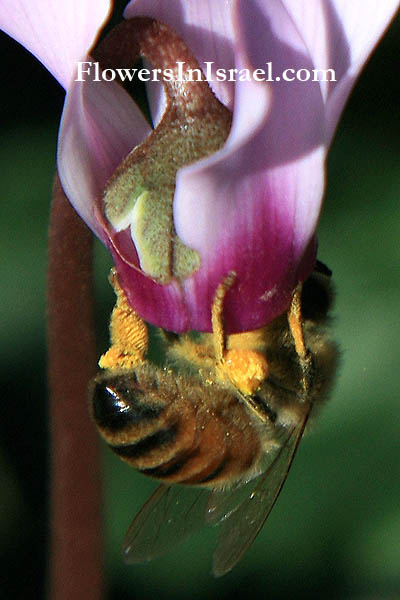
Location: Judean Mountains, Eshtaol Forest |
| Life form: | Geophyte, growing from a tuber | |
| Stems: | Upright; flower stem is bent 150-180° at the tip, so that the nose of the flower faces downwards | |
| Leaves: | Rosette, entire, heart-shaped | |
| Flowers: | Solitary and nodding; 5 twisted reflexed petals that are joined shortly at base; violet, white | |
| Fruits / pods: | Round pod; 14-16 mm in diameter | |
| Flowering Period: | January, February, March, April, December | |
| Habitat: | Mediterranean maquis and forest, Batha, Phrygana | |
| Distribution: | Mediterranean Woodlands and Shrublands, Semi-steppe shrublands, Montane vegetation of Mt. Hermon | |
| Chorotype: | Mediterranean | |
| Summer shedding: | Ephemeral |

Location: Road 3415, Gad Hills (Givad Gad) Derivation of the botanical name: Cyclamen, Greek, kyklaminos, kyklaminon used by Dioscorides and Theophrastus, possibly from kyklos "cirkle, round, ring, circular, globe," referring to the shape of the leaf or to the rounded tubers; Latin cuclaminos, cyclaminon (Plinius) for the plant sowbread. persicum, of Persia. The Hebrew name: רקפת, Rakefet, after the Syrian name Rakafta.
Cyclamen, a genus of plants of the Primrose family, received its name kyklaminos meaning "circle" from its bulblike, underground stem. In most of the 20 known species, the flower scape coils downward after pollination. The ripe seed are then shed near the soil. The flowers are produced in whorls of 3-10, each flower on a slender stem 3-12 cm tall, with five united petals; the petals are usually reflexed back 90° to 180° erect above the flower, and vary from white through pink to red-purple, most commonly pale pink. Cyclamen persicum is the parent species of the cultivated Cyclamen; they are tuberous plants native to the eastern Mediterranean -southern Turkey, Syria, Lebanon, Jordan and Israel. They grow in the wild as well in Algeria, Tunisia and on the Greek islands of Rhodes, Karpathos and Crete. It is thought that the cyclamen in North Africa and the Greek islands were introduced by monks or other religious orders for they are often found near old monasteries or cemeteries. The popular name for Cyclamen in Arabic is Sabounat al- Raa'i, סבונת אל-רעי, i.e. soap of the shepherd, testifying that the herdsmen recognized the foaming qualities of Saponin in it and used the leaves or tuber as soap in emergency time. Cyclamen contains a toxic saponin, cyclamin, in the tuberous rhizomes. The extreme acridity would be fair warning not to eat it. Many English farmers called Cyclamen "stag-truffle" or "sowbread" and in the herbals cyclamen were referred to as sow-bread or Panis porcinus; wild pigs were supposedly fond of the tubers and digging them in the ground with their snouts. See the list of Medicinal herbs in Israel, the parts used and their medical uses to treat various diseases. Pedanius Dioscorides, an ancient Greek physician, pharmacologist and botanist who practised in Rome at the times of Nero in the first century CE. He is famous for writing a five volume book De Materia Medica, not just for the history of herbal science; it also gives us knowledge of the herbs and remedies used by the Greeks, Romans, and other cultures of antiquity. Among the "ciclamino" were put many medical uses: women who wished to end their pregnancies would walk over flowering cyclamens in the belief that this could induce miscarriages, it counteracts any kind of poison, especially sea air, it is good against serpent's bite and make a man drunk if it was put in his wine. Ointments made with oil or honey were believed good to treat cataracts and weak eyesight, cleanse the skin to cure blemishes and boils, treat sunburn, and make hair grow. Dioscorides suggested its use also as a purgative, antitoxin, skin cleanser, and labor-inducer. When used as a purgative, juice from the tuberous root-stock was applied externally, either over the bowels and bladder region or on the anus. Dioscorides also mentioned its use as an aphrodisiac and that the seeds removed sorcery. Theophrastus (372-287 B.C.) noted that the cyclamen was a symbol of lust because of its use as an aphrodisiac. And no doubt of the folkloric custom preparing real aphrodisiac of the cyclamen; the powder has no sense of smell, colour and taste, and a woman, who wanted to arouse her man, put it in the soup without showing anything, and went quickly to bed. Cyclamen tubers were baked and made into cakes and eaten as a love potion. Powdered cyclamen tubers were and still are used for poisoning fish; if you scatter it on water the fish will float to be able to breathe so that they are an easy catch. The Roman author Pliny also spoke of cyclamens used as a toxic fish bait. 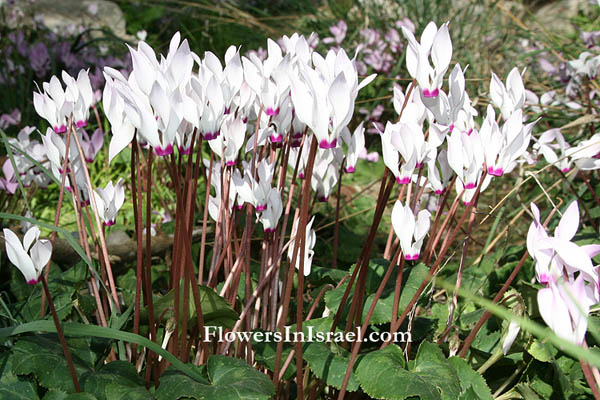
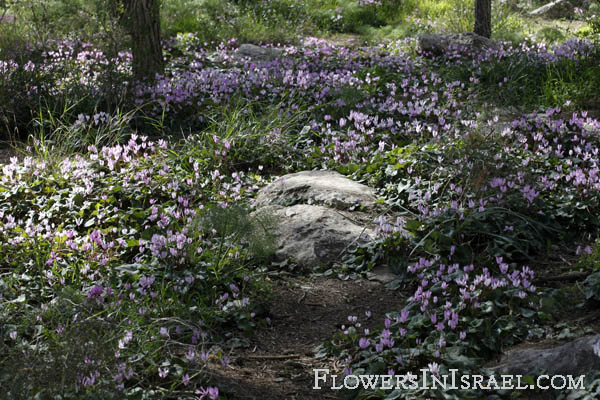
Location: Road 3415, Gad Hills (Givad Gad) And then you can sing the popular Israeli song: "Cyclamen" Lyrics: Levin Kipnis Music: Folk Singer:Esther Ofarim Under the rock grows like a wonder A very cute Cyclamen The shining sun kisses it And crowns her with a pink crown The bird whistles Look at me for a minute Beautiful Cyclamen hiding under the rock Hiding from every thing Bat sheva went out for a walk The morning was bright She collected every flower and plant Her mouth full with a song Bat sheva sings Cyclamen speeds up peeps out for a moment Who is looking at me here? That’s CyclamenBat sheva gets closer slowly Bat sheva gets off the rock A beautiful Cyclamen on her chest A bird whistles the wind folndles And this song comes to an end. "Rakefet" Mitachat lasela tzomachat lefele Rakefet nechmedet me’od Veshemesh mazheret nosheket oteret Oteret la keter varod Rakefet rakefet tzipor metzaftzefet Hatzitzi ach rega elai Rakefet nehederet basela nisteret Nisteret minefesh kol chai Yatza’a im haruach rakefet lasuach Haya az haboker bahir Kol tzemach kol perach osefet baderech Ufia ach zemer vashir Bat sheva mezameret rakefet memaheret Metzitza ach rega echad Mi zot hanishkefet achen zo rakefet Bat sheva nigheshet le’at Misela vageva yoredet Bat sheva Rakefet chen al hechaze Tzipor metzaftzefet veruach lotefet Vesof kvar lazemer haze. ***** "רקפת" מלים: לוין קיפניס מתחת לסלע צומחת לפלא ,רקפת נחמדת מאוד ,ושמו מזהרת נושקת עוטרת .עוטרת לה כתר ורד "רקפת, רקפת" צפור מצפצפת "הציצי אך רגע אלי!" רקפת נהדרת בסלע נסתרת .נסתרת מנפש כל הי ,יצאה עם הרוח בת-שבע לשוח ;היה אז הבקר בהיר כל צמח, כל פרח אוספת בדרך ופיה אל זמר ושיר... ללללל בת-שבע מזמרת – רקפת ממהרת ...מציצה אך רגע אחד !מי זאת הנשקפת? אכן זו רקפת בת-שבע נגשת לאט... ללללל מסלע ונגבע יורדת בת-שבע ...רקפת-חן על החזה ציפור מצפצפת ורוח לוטפת .וסוף כפר לזמר הזה ***** 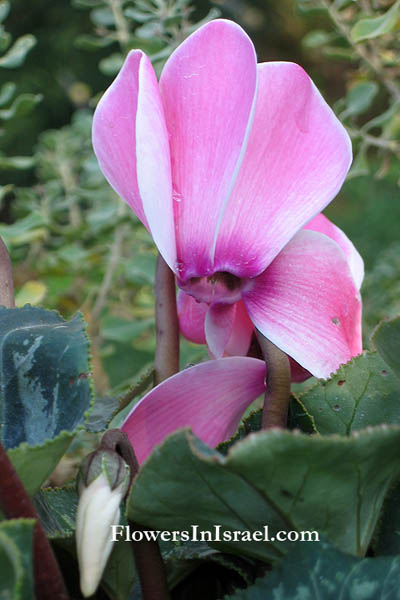
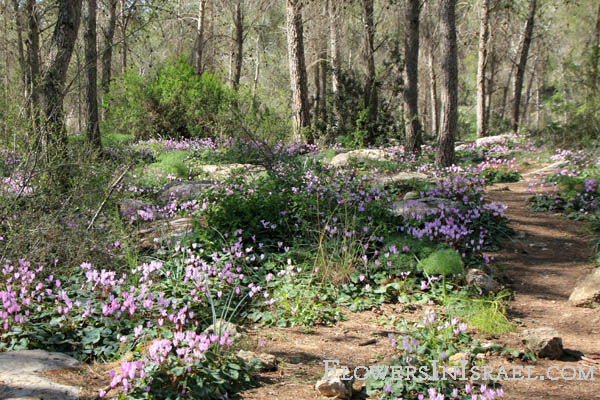
Location: Road 3415, Gad Hills (Givad Gad) 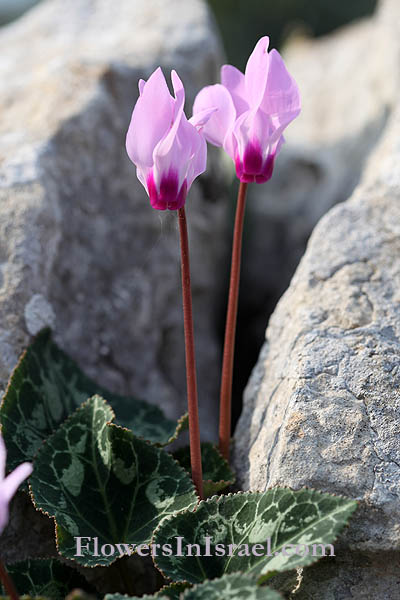
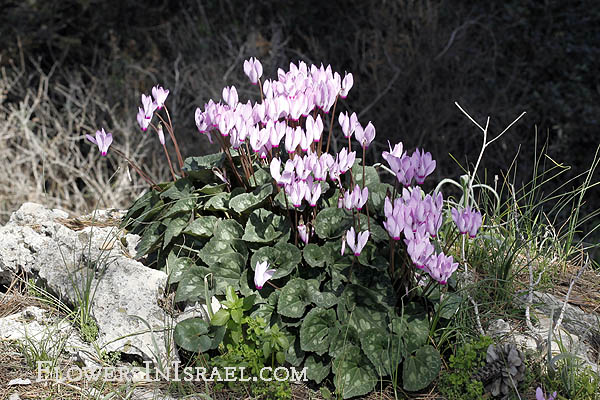
Location: Road 3415, Gad Hills (Givad Gad) In Israel you will find Cyclamen galore in many places, but special on the Cyclamen Hill (Rakafot Hill) near Kibbutz Galed. From Eliakim Junction on the Fureidis-Yokneam road (near Yokneam), take Route 672 southward to Kibbutz Galed. In 1950 a pine forest was planted and a few years later Cyclamen started to grow, flowering end January- begin February. |